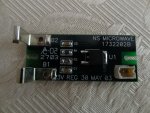VancouverScan
Member
I picked up a used R5, first thing I noticed was a hole in the battery cover and inside was a 2 pin connector. Upon opening battery compartment, there is a small PC board inside, no room for batteries, it has a name on it, NS Microwave. It appears it was from Gov't surplus, it also came with an unusual BNC antenna on thin coax to an SMA connector, I tested antenna for peak frequency range and it is centered at 166.500MHz.
Anyone know anything about this board and how to use it? I can add a picture if needed of the board.
Thanks.
Anyone know anything about this board and how to use it? I can add a picture if needed of the board.
Thanks.



